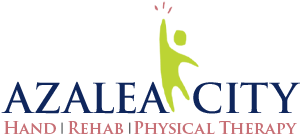Tendonitis Relief In Mobile AL

Tendonitis in Mobile AL is one of those conditions that can sneak up on you and make daily tasks feel nearly impossible. Whether you're an athlete pushing your limits or someone who spends hours typing at a desk, tendonitis can creep in and cause pain, stiffness, and frustration. Fortunately, tendonitis doesn't have to be a permanent setback. With the right approach-especially with the help of physical therapy/occupational therapy-you can alleviate your symptoms and prevent long-term damage.
Azalea City Hand and Rehab and Physical Therapy has everything you need to know about tendonitis, from its causes and symptoms to how physical therapy/occupational therapy can help you recover and get back to your routine without pain.
What Is Tendonitis in Mobile AL?
Tendonitis refers to inflammation or irritation of a tendon, the thick cords of tissue that connect muscles to bones. Tendons are responsible for transmitting the force generated by muscles, allowing you to move your joints. When these tendons become inflamed due to overuse, injury, or strain, the result is pain and tenderness around the affected joint.
Tendonitis can occur in any tendon, but it's most common in areas where repetitive motion or stress is frequent, such as the shoulders, elbows, wrists, knees, and ankles. Some of the most common forms of tendonitis include tennis elbow, golfer's elbow, Achilles tendonitis, and rotator cuff tendonitis. Left untreated, tendonitis can lead to more serious conditions, such as tendon tears or chronic tendonitis, where the inflammation becomes long-term.
Symptoms of Tendonitis in Mobile AL
Tendonitis symptoms can vary depending on the location and severity of the inflammation, but there are some common signs that indicate you might be dealing with this condition. If you're experiencing any of the following symptoms, it's worth considering that tendonitis may be the cause:
- Pain: The most prominent symptom of tendonitis is localized pain at the site of the affected tendon. This pain may worsen with movement or physical activity, especially those that involve repetitive motions.
- Tenderness: The area around the tendon may feel tender to the touch, and you may notice swelling or warmth around the joint.
- Stiffness: Many people with tendonitis experience stiffness, particularly in the morning or after periods of inactivity. This stiffness can make it difficult to move the affected joint.
- Weakness: Tendonitis can cause muscle weakness, making it hard to perform everyday tasks, such as lifting objects or gripping items.
- Grinding or Crackling Sensation: In some cases, tendonitis may cause a sensation of grinding or crackling (called crepitus) when you move the affected joint.
If left untreated, these symptoms can worsen, leading to more severe pain and long-term complications. That's why it's important to address tendonitis early and seek appropriate care.
What Causes Tendonitis?
Tendonitis is most often caused by repetitive motions or overuse of a tendon, but there are several factors that can contribute to its development. Let's explore the most common causes:
- Repetitive Motion: Repeating the same movement over and over again, especially without proper form or technique, can strain a tendon and lead to inflammation. This is common in athletes, musicians, and individuals with jobs that require repetitive tasks.
- Sudden Increase in Activity: Tendonitis can occur when you suddenly increase the intensity or duration of an activity without allowing your tendons time to adjust. This is why athletes who ramp up their training too quickly are at higher risk of developing tendonitis.
- Aging: As we age, tendons become less flexible and more prone to injury. This natural wear and tear can make tendonitis more common in older adults, even with low-impact activities.
- Poor Posture and Body Mechanics: Engaging in activities with poor posture or improper body mechanics can place undue stress on your tendons. Whether you're sitting at a desk, lifting heavy objects, or performing exercises, incorrect positioning can lead to tendon irritation.
- Injury or Trauma: A direct injury to a tendon-such as a fall, a collision, or a sudden twist-can cause tendonitis by damaging the tendon tissue and triggering inflammation.
- Health Conditions: Certain medical conditions, such as diabetes or rheumatoid arthritis, can increase your risk of developing tendonitis due to underlying inflammation and tissue degeneration.
By identifying the cause of your tendonitis, you can take steps to modify your activities and prevent the condition from recurring.
How Is Tendonitis Diagnosed?
If you suspect you have tendonitis, it's important to get a proper diagnosis to confirm the condition and rule out other potential issues, such as a tendon tear or joint problem. A healthcare provider, such as a physical therapist or doctor, will conduct a thorough evaluation that may include:
- Physical Examination: Your healthcare provider will examine the affected area for signs of tenderness, swelling, and limited range of motion. They'll also ask about your symptoms, including when the pain started and what activities trigger it.
- Range of Motion and Strength Tests: You may be asked to perform specific movements to assess your joint mobility and muscle strength. This helps determine how much the tendon is affected by the inflammation.
- Imaging Tests: In some cases, imaging tests like X-rays, ultrasounds, or MRIs may be recommended to get a clearer view of the tendon and rule out other conditions, such as fractures or arthritis.
Once diagnosed, you can work with your healthcare provider to develop a treatment plan tailored to your needs-this is where physical therapy/occupational therapy can make a significant difference.
How Physical Therapy/Occupational Therapy Helps People with Tendonitis
Physical therapy/occupational therapy is one of the most effective treatments for tendonitis, offering a non-invasive way to reduce pain, improve mobility, and prevent further injury. Here's how physical therapy/occupational therapy can help you recover from tendonitis:
1. Pain Relief and Inflammation Reduction
One of the primary goals of physical therapy/occupational therapy is to reduce pain and inflammation. Your physical therapist will use various techniques to alleviate your symptoms and promote healing:
- Manual Therapy: Hands-on techniques, such as massage and soft tissue mobilization, can help improve blood flow to the tendon, reduce tension in surrounding muscles, and ease pain.
- Ice and Heat Therapy: Applying ice to the affected area can help reduce inflammation and numb the pain, while heat can promote healing by increasing circulation to the tendon.
- Electrotherapy: Modalities such as electrical stimulation or ultrasound therapy may be used to target pain and encourage tissue healing.
2. Restoring Mobility and Flexibility
Tendonitis often causes stiffness and limited range of motion, making it difficult to move the affected joint. Physical therapy/occupational therapy focuses on restoring flexibility and improving your ability to move freely:
- Stretching Exercises: Your physical therapist will guide you through gentle stretching exercises that target the affected tendon and surrounding muscles. Stretching helps improve flexibility and reduce tension, allowing for smoother movement.
- Joint Mobilization: In some cases, your therapist may use joint mobilization techniques to gently move the joint and improve mobility. This can be especially helpful if stiffness is contributing to your pain.
3. Strengthening the Affected Tendon and Muscles
Strengthening the muscles around the affected tendon is crucial for preventing future injuries. Physical therapy/occupational therapy includes exercises designed to build strength and endurance in these muscles:
- Eccentric Strengthening Exercises: Eccentric exercises involve lengthening the muscle while it's under tension, which helps improve the tendon's ability to handle stress. These exercises are often used to treat tendonitis in the Achilles tendon, patellar tendon, and other commonly affected areas.
- Resistance Training: Your physical therapist will introduce resistance exercises using bands, weights, or your body weight to gradually increase the strength of the affected muscles. This helps support the tendon and reduce the risk of further inflammation.
4. Addressing Posture and Mechanics
If poor posture or improper body mechanics are contributing to your tendonitis, physical therapy/occupational therapy will include education on how to move more efficiently and reduce strain on the tendon:
- Posture Correction: Your therapist will assess your posture and provide guidance on how to maintain proper alignment during activities such as sitting, standing, and lifting.
- Ergonomic Adjustments: If your tendonitis is related to work or recreational activities, your therapist may recommend ergonomic changes, such as adjusting your desk setup or using proper form during exercise.
5. Preventing Future Tendonitis Flare-Ups
Physical therapy/occupational therapy not only helps you recover from tendonitis but also provides tools to prevent future flare-ups. Your therapist will create a personalized exercise plan that you can continue at home to maintain strength, flexibility, and tendon health. By following your therapist's recommendations, you can reduce the risk of re-injury and keep your tendons strong.
What Should You Do If You Think You Have Tendonitis?
If you're experiencing symptoms of tendonitis, it's important to take action early to prevent the condition from worsening. Here's what you should do:
- Rest the Affected Area: Give your tendon a break from repetitive activities that could be causing the inflammation. Avoid overuse and allow the tendon time to heal.
- Apply Ice: To reduce swelling and ease pain, apply an ice pack to the affected area for 15-20 minutes at a time, several times a day.
- Consult a Physical Therapist: A physical therapist can help you identify the cause of your tendonitis and create a personalized treatment plan. Early intervention with physical therapy/occupational therapy can speed up your recovery and prevent long-term damage.
- Modify Your Activities: If certain activities are triggering your symptoms, make adjustments to reduce strain on the tendon. Your physical therapist can recommend modifications to help you continue with your routine while protecting your tendon.
Find Relief From Tendonitis with Physical Therapy/Occupational Therapy
Tendonitis doesn't have to hold you back from the activities you love. With the right treatment, especially physical therapy/occupational therapy, you can reduce pain, restore function, and prevent future injuries. By addressing the root causes of tendonitis, Azalea City Hand and Rehab and Physical Therapy's physical therapy/occupational therapy helps you regain control over your body and avoid long-term complications.
If you think you might have tendonitis, don't wait-schedule a consultation with one of the best Mobile AL physical therapists today and start your journey to a pain-free, active lifestyle.
OFFICE HOURS
Monday
8:00am - 5:00pm
Tuesday
8:00am - 5:00pm
Wednesday
8:00am - 5:00pm
Thursday
8:00am - 5:00pm
Friday
8:00am - 12:00pm
Saturday & Sunday
Closed
Azalea City Hand and Rehab and Physical Therapy
316 S Sage Ave Ste C
Mobile, AL 36606


